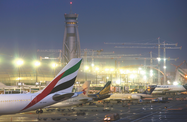A new aviation district in Dubai is set to spearhead growth across the maintenance, repair and overhaul (MRO) industry, while strengthening the emirate’s position as one of the world’s largest air transport hubs.
Covering an area of 6.7 sq km, the district’s key focus will be the provision of facilities for MRO and operational support companies, both airside and landside, in addition to training and R&D initiatives.
In for the long haul
The aviation district will be located next to Al Maktoum International Airport at Dubai World Central (DWC), which has been operational as an aviation cargo centre since 2010 and late last year opened its first passenger terminal. When completed, the airport will have the capacity to transport 160m people and 12m tonnes of cargo annually. The emirate has yet to say whether the hub will replace Dubai International Airport (DXB), or operate alongside it.
Expansion and runway maintenance scheduled for DXB this summer are set to produce a short-term increase in traffic at the new airport. Malaysia Airlines has already signalled its intention to shift its flights from DXB to Al Maktoum International while the work takes place, with other airlines likely to follow.
Officially unveiled in early February at the emirate’s 2014 MRO conference, the aviation district marks the latest in a series of initiatives earmarked for DWC, which is owned by Dubai Aviation City Corporation.
Rashed Bu Qara’a, Dubai Aviation City Corporation’s COO, told reporters at the conference that the facility would offer international MRO companies a means of strengthening their presence in the region. He added that the district’s mix of aviation business elements had already “attracted the attention of major industry players”.
Carriers eye expansion
Dubai’s MRO industry has benefited from a move by regional carriers in recent months to expand their fleets. Emirates Airlines, Airbus’s biggest customer, placed an order for 50 planes last year, which will trigger demand for additional maintenance and servicing. With business in the emirates on the rise, Airbus is now considering the region as a destination for housing spare parts, currently mostly located in London and Kuala Lumpur.
Other carriers such as Etihad Airways and Qatar Airways are building up their fleets, making the region increasingly important for aircraft manufactures, as well as companies that produce key components such as engine maker Rolls-Royce.
Several locally owned firms have also embarked on an expansion. Dubai Aerospace Enterprise recently placed a $1bn order for 40 new aircraft to develop leasing operations throughout the region.
Speaking to Gulf News, Will Horton, a senior analyst at CAPA - Centre for Aviation, an industry market intelligence vendor, acknowledged that the expansion of aircraft leasing in the Gulf away from its traditional locations in North America and Europe was significant. “With the new wealth in the Middle East and Asia, these regions are increasingly capitalising on keeping money within the region and being centres for leasing,” he said.
Meanwhile, dnata, a combined air services firm, and part of The Emirates Group, announced this month that it would be adding aircraft line maintenance to its operations division.
On the move
While regional and local trends are strong, investors will be aware that the transition taking place at Dubai’s air hubs leaves some questions unanswered.
Both airports are earmarked to be global giants. Once operating at full capacity, Al Maktoum International will surpass passenger-handling capabilities at Heathrow, which is currently the world’s busiest airport. DXB, meanwhile, will be capable of handling around 100m passengers annually when its expansion is complete, enabling it to match, if not edge, the London hub. However, uncertainty about whether the larger carriers will shift from one airport to another may raise questions of timing among MRO players, suppliers and other service companies that are looking to invest.
While clarification is needed about the future roles earmarked for Dubai’s airports, the emirate looks to be fast edging towards the title of world’s largest aviation hub. MRO and service companies will be a key component of the industry’s expansion, while the new aviation district should help facilitate successful growth and support the sector during its transitional phase and beyond.
Follow Oxford Business Group on Facebook, Google+ and Twitter for all the latest Economic News Updates. Or register to receive updates via email.

